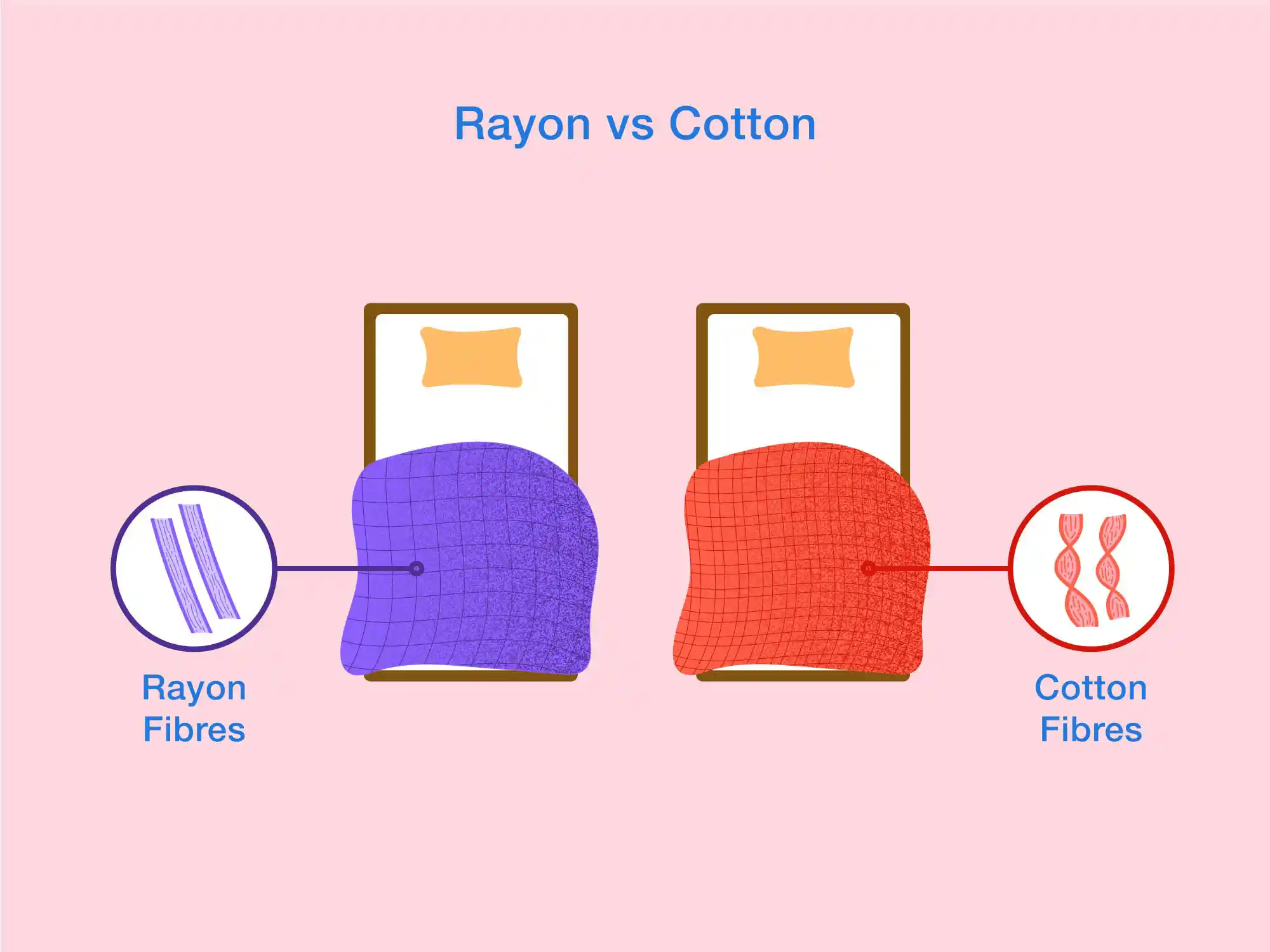Bedding
Published January 31, 2023
12 minRayon vs Cotton: What is the Difference?
Rayon and cotton are two popular fabrics for sheets. While cotton is soft and breathable, rayon offers a smooth semi-synthetic feel. However, rayon and cotton are both lightweight and perfect for summ

Table of contents
What are Rayon Sheets? Pros and Cons of Rayon Types of Rayon What are Cotton Sheets? Pros and Cons of Cotton Types of CottonWhat is the Difference Between Rayon and Cotton? Frequently Asked Questions
Rayon and cotton are two popular fabrics for sheets. While cotton is soft and breathable, rayon offers a smooth semi-synthetic feel. However, rayon and cotton are both lightweight and perfect for summer. But which is the best for you? We are here with all the information you need. In today’s article, we will give you all the differences between rayon vs cotton, so you can decide which is the right fit for you.
This table gives you a quick overview of the differences between cotton vs rayon.
| Parameter | Rayon | Cotton |
|---|---|---|
| Origin | Comes from chemically processed wood pulp | Comes from cotton plants |
| Strength | They become weak when they are wet | While it depends on the quality, it offers tensile strength |
| Durability | When you give it proper care, it can last for long | They are durable but can be prone to stretch out and pill |
| Softness | They are softer than any other synthetic fabrics | It is extremely soft and comfortable |
| Elasticity | Not elastic, but can be when mixed with spandex | Not very elastic, but can be when made with knit fabric |
| Absorbency | More absorbent when compared to cotton | They are very absorbent but may not dry quickly |
| Pilling | Doesn’t pill | Pills over time |
| Wrinkling | Doesn’t wrinkle easily | Wrinkles easily |
| Sustainability | Can be considered more eco-friendly than other synthetic fibers but production uses harmful chemicals | Renewable source but may not always be eco-friendly |
| Care | May need dry cleaning | It can be easily machine washed |
| Cost | Can be slightly expensive when compared to other synthetic fabrics | May be expensive depending on quality |
| Uses | Used for clothing, sheets, drapes and more | Clothing to bedding, it is used for almost everything |
What are Rayon Sheets?
Did you know? Rayon was invented in the 1800s as a substitute for silk. And what a great substitute it is. Rayon is smooth and soft. It can also be categorized as semi-synthetic or biosynthetic. Rayon is curated from chemically processed wood or bamboo pulp to alter its physical state. Rayon fibers are neither considered natural nor artificial. While it starts with a natural source, the chemical process regenerates it into alkali cellulose.It goes through another treatment and changes structure into cellulose xanthate. Finally, after various procedures, you get the silky smooth rayon.Pros and Cons of Rayon
Let’s understand all the disadvantages and advantages of rayon.Pros
- It is inexpensive
- It has a silky finish
- It is smooth and drapes beautifully
- Ideal for those looking for a budget-friendly product that exudes luxuriousness
- It dyes very easily and can be converted into vibrant hues
Cons
- The process can lead to pollution
- They almost need to be dry-cleaned every time
- It is prone to stretching and bagging
- The fabric is not very strong and becomes weaker when wet
- It can easily absorb body oils, sweat, and more, leading to spots
Types of Rayon
Let’s understand more about the popular types of rayon.Viscose
Viscose is an alternative to cotton or polyester. It is also a durable option when compared to silk. It is quite popular in the fashion industry, where it is used to weave draped skirts or dresses, soft blouses, and more. That said, bedding made of viscose is in demand too.Modal
Modal is a breathable alternative to cotton used to make activewear. From pajamas to robes to sheets, they are everywhere. Modal and viscose have the same process. However, with modal, there is an additional process where it is turned into something more potent than viscose.Lyocell
Lyocell is another semi-synthetic rayon fabric, regenerated cellulose made of a dissolving pump. It is used for clothing, sheets, and so much more. It shares the properties of cotton, silk, and linen. It was developed in 1972 but gained popularity only in the 20th Century. The fabric is soft to the touch and also strong.What are Cotton Sheets?
Did you know? The word cotton is derived from the Arabic word quton, and the earliest production of cotton dates back to the fifth millennium BC when it was grown in India. Cotton is a soft and fluffy fiber that grows in small balls. This is pure cellulose spun into yarn to make soft and breathable textiles. It is a staple textile today. From being in the fashion industry's center to being used in the making of towels, sheets, and more, cotton is a durable material. Today, a variety of cotton sheets are available whose prices vary depending on their quality. Caring for cotton is relatively easy; more often than not, it can be machine washed. However, it is essential to know that they can wrinkle very easily.Pros and Cons of Cotton
Let’s understand cotton's pros and cons and see if it is the right fabric for you!Pros
- Cotton is too comfortable and a naturally sustainable textile
- It is hypoallergenic
- It is odor-free
- It is low maintenance and versatile
- It is breathable
- Unlike synthetic fabric, it doesn’t release microplastics when washed
- It is a perfect fabric for all seasons
- It is a natural fabric and incredibly strong
- It is compostable
Cons
- Cotton can fade over time
- Cotton can bleed color when washed
- It wrinkles very easily
- It can shrink when washed in hot water
- It is not completely sustainable
- Conventional cotton may contain pesticides
- Cotton crops need a lot of water
Types of Cotton
Some of the most popular cotton sheet types include;Pima
Pima is an ultra-soft fabric made of long cotton fibers. It is an ELS or extra-long staple, which means the quality of this cotton is high. They are made of fibers longer than 34 millimeters. Pima comes from a particular type of cotton plant, Gossypium barbadense, found in tropical areas.Pima is a rich and luxurious fabric, which can be heavy on the pocket. But since it is durable and resistant to pilling, it can be an investment.Egyptian
When it comes to luxurious sheets, Egyptian sheets take the cake! Due to the superiority it offers, Egyptian sheets can be expensive. Egyptian cotton is grown under unique climate conditions and is probably the strongest, softest, and most beautiful worldwide. Egyptian cotton sheets are extra-long staples and have a higher thread count. If you want luxury, you cannot go wrong with Egyptian cotton.Upland
Also known as Mexican cotton, is native to Americans and was discovered in Mexico about 5,000 years ago. It is short and medium staple cotton. People tend to think it is a cheaper type of cotton. However, it comes with rougher threads and may not be as soft as some other types.Organic
Organic cotton is grown using methods that don’t harm the environment. It doesn’t have any pesticides and is a sustainable option. Organic cotton sheets are incredibly soft and feel luxe.What is the Difference Between Rayon and Cotton?
Let’s walk through some of the differences between rayon and cotton. While cotton has been around for ages, it was only in the 1880s that rayon came into existence. The cotton textile comes from the cotton plant, whereas rayon comes from the wood chips of different trees. Fiber: Cotton is an all-natural fiber, whereas rayon is part natural and part synthetic. But the drawback of the cotton fabric is that you need a lot of water to grow and nurture the cotton plant. Hence, it is not too eco-friendly.Strength:
If you are looking for something durable and stronger, cotton is your best choice as it is stronger when compared to rayon. In fact, cotton clothes such as t-shirts or dresses tend to last longer and remain fresh even after several washes. Rayon, on the other hand, has great tensile strength when it is dry but gets weaker when wet. It can lead to stretching, shrinking, and even tearing when exposed to moisture. However, this is not the case with cotton.Durability
Regarding durability, both rayon and cotton are average in nature. While they are durable, they may only last for a while. That said, cotton has a tough cellular structure compared to rayon, so it has good durability. But prone to pilling and may also fade over time.Softness
If you are looking for the softest fabric in town, you cannot go wrong with cotton. However, rayon has a silky surface, feels smooth against the skin, and is not very soft. But when you compare rayon with other synthetic fabrics, it is probably the softest of the lot.Elasticity
Cotton is more elastic compared to rayon. While cotton can stretch up to 5% of its length, rayon doesn’t. Sometimes, makers create rayon with a blend of spandex, and here it becomes elastic.Absorbency
Both materials have good absorbency, but when compared, rayon is better. You must have noticed how cotton clothes soak any perspiration. In fact, if it is loosely woven cotton, the threads tend to hold on to the moisture for a long time. Whereas rayon absorbs moisture well.Pilling
When you compare rayon with cheap quality cotton, the former’s pilling is better. However, compared with high-quality cotton, it sustains without pilling for a very long time.Wrinkles
Cotton fabric tends to wrinkle very quickly, and that’s not the case with rayon. It is excellent when it comes to wrinkle and fade resistance. But if it is exposed to too much moisture or heat, it can get damaged easily.Sustainable
When we compare it with the form of production, rayon can be categorized as sustainable. But, it can lead to deforestation and its production needs chemicals. Cotton is all-natural and a renewable resource.Care
Cotton is easy to care for and can be machine-washed hassle-free, at least in most cases. However, that’s not the case with rayon; dry cleaning may be necessary here.Cost
It all depends on the quality! If you compare cheaper quality cotton with higher quality rayon, the latter is more expensive. But when it comes to sheets, cotton sheets are expensive when compared to rayon.Uses
Both cotton and rayon are used to make a variety of things. From clothes to sheets and more. But cotton is more versatile when compared to rayon.Now you are well aware of all the differences between rayon vs cotton. While rayon and cotton are derived from plants and trees, rayon is not ideal for the environment. Cotton is a natural fiber, breathable and hypoallergenic, however, it contains pesticides and uses lots of water to grow. Here, organic cotton can be an ideal option.This article is for informational purposes and should not replace advice from your doctor or other medical professional.Frequently Asked Questions
Does rayon breathe like cotton? While varieties of rayon, such as viscose may often feel like cotton, it doesn’t have the same breathability or absorption capacity as cotton. That said, it also doesn’t trap any heat like nylon. But it can repel water, making you feel very sweaty. What are the disadvantages of rayon? Some of the main disadvantages of rayon include;- It is made from a chemical process, which can cause pollution
- You cannot easily machine wash the fabric, and most of the time, dry cleaning is the only option
- When wet, it becomes very weak and can be prone to stretching or shrinking











